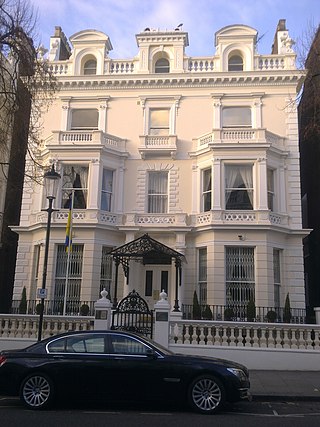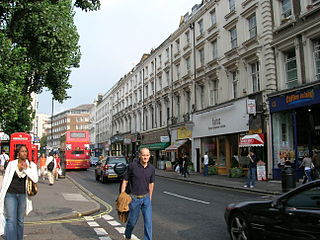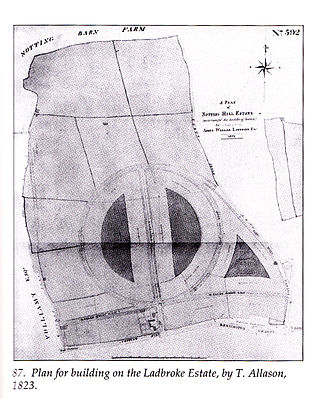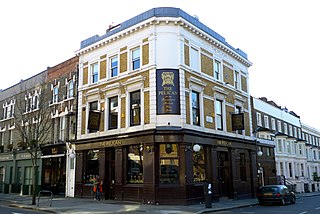
Notting Hill is a district of West London, England, in the Royal Borough of Kensington and Chelsea. Notting Hill is known for being a cosmopolitan and multicultural neighbourhood, hosting the annual Notting Hill Carnival and the Portobello Road Market. From around 1870, Notting Hill had an association with artists.

Portobello Road is a street in the Notting Hill district of the Royal Borough of Kensington and Chelsea in West London. It runs almost the length of Notting Hill from South to North, roughly parallel with Ladbroke Grove. On Saturdays it is home to Portobello Road Market, one of London's notable street markets, known for its second-hand clothes, pastries and antiques. Every August since 1996, the Portobello Film Festival has been held in locations around Portobello Road and, in 2015, Portobello Radio was founded as the area's community radio station.

Holland Park is an area of Kensington, on the western edge of Central London, that lies within the Royal Borough of Kensington and Chelsea and largely surrounds its namesake park, Holland Park.

Ladbroke Grove is a road in the Royal Borough of Kensington and Chelsea, London, England, which passes through Kensal Green and Notting Hill, running north–south between Harrow Road and Holland Park Avenue.

Westbourne Grove is a retail road running across Notting Hill, an area of west London. Its western end is in the Royal Borough of Kensington and Chelsea and its eastern end is in the City of Westminster; it runs from Kensington Park Road in the west to Queensway in the east, crossing over Portobello Road. It contains a mixture of independent and chain retailers, and has been termed both "fashionable" and "up-and-coming".

Notting Hill Gate is one of the main thoroughfares in the Royal Borough of Kensington and Chelsea. Historically the street was a location for toll gates, from which it derives its modern name.

Queensway is a shopping street in Bayswater, an area of west London. It is home to Whiteleys, many restaurants, cafés, pubs, souvenir shops and a few high-street retail chains. Queensway and Westbourne Grove are identified in the London Plan as one of 35 major centres in Greater London. The street is numbered the B411 in the British road numbering scheme. Queensway is currently undergoing a major redevelopment on all sides, with a building on the top of the road being developed for £500m, Whiteleys for £1.2BN and a series of other redevelopments happening at the same time.

The Tabernacle is a Grade II-listed building in Powis Square, Notting Hill, west London, England, built in 1887 as a church. The building boasts a curved Romanesque façade of red brick and terracotta, and two towers with broach spires on either side. Today the Tabernacle serves as a cultural arts and entertainment venue, including a theatre, meeting rooms, music studio, art gallery, bar and kitchen, conservatory and a garden courtyard.

Ronald "Charlie" Phillips, also known by the nickname "Smokey", is a Jamaican-born restaurateur, photographer, and documenter of black London. He is now best known for his photographs of Notting Hill during the period of West Indian migration to London; however, his subject matter has also included film stars and student protests, with his photographs having appeared in Stern, Harper’s Bazaar, Life and Vogue and in Italian and Swiss journals. Notable recent shows by Phillips include How Great Thou Art, "a sensitive photographic documentary of the social and emotional traditions that surround death in London's African Caribbean community".

Colville Gardens is a Victorian cul-de-sac street in the Royal Borough of Kensington and Chelsea, located north of Colville Terrace and east of the Portobello Market in Notting Hill, London, England. It is bordered on the north side by All Saints' Church.

St John's Notting Hill is a Victorian Anglican church built in 1845 in Lansdowne Crescent, Notting Hill, London, designed by the architects John Hargrave Stevens (1805/6–1857) and George Alexander (1810–1885), and built in the Victorian Gothic style. Dedicated to St John the Evangelist, the church was originally built as the centrepiece of the Ladbroke Estate, a mid nineteenth century housing development designed to attract upper- and upper middle-class residents to what was then a largely rural neighbourhood in the western suburbs of London.

St Peter's Notting Hill is a Victorian Anglican church in Kensington Park Road, Notting Hill, London. Designed in the classical style by architect Thomas Allom, work was begun in 1855 and completed in 1857.

The Ladbroke Estate was a substantial estate of land owned by the Ladbroke family in Notting Hill, London, England, in the early 19th century that was gradually developed and turned into housing during the middle years of the century, as London expanded. Characterized by terraces of stuccoed brick houses backing onto large private garden squares, much of the original building remains intact today, and now forms the heart of one of London's most expensive and fashionable neighbourhoods.

Rhaune Laslett was an English community activist and the principal organiser of the Notting Hill Fayre or Festival, that evolved into the Notting Hill Carnival.

Powis Square is a garden square and locality in Notting Hill, in the Royal Borough of Kensington and Chelsea in London, England. The closest London Underground station to the square is Westbourne Park tube station.

Golborne Road is a street in the Royal Borough of Kensington and Chelsea in London's Kensal Town. The road runs east from Portobello Road to Kensal Road.

Elgin Crescent is a street in Notting Hill, London, England.

Lancaster Road (West) Estate is a housing estate in North Kensington, west London.

Rhodan Gordon was a Black British community activist, who migrated to London from Grenada in the 1960s. He came to public attention in 1970 as one of the nine protestors, known as the Mangrove Nine, arrested and tried on charges that included conspiracy to incite a riot, following a protest against repeated police raids of The Mangrove restaurant in Notting Hill, London. They were all acquitted of the most serious charges and the trial became the first judicial acknowledgement of behaviour motivated by racial hatred, rather than legitimate crime control, within the Metropolitan Police.

All Saints Road is a street in London's Notting Hill district, best known as being an important centre for the UK's Afro-Caribbean community.




















